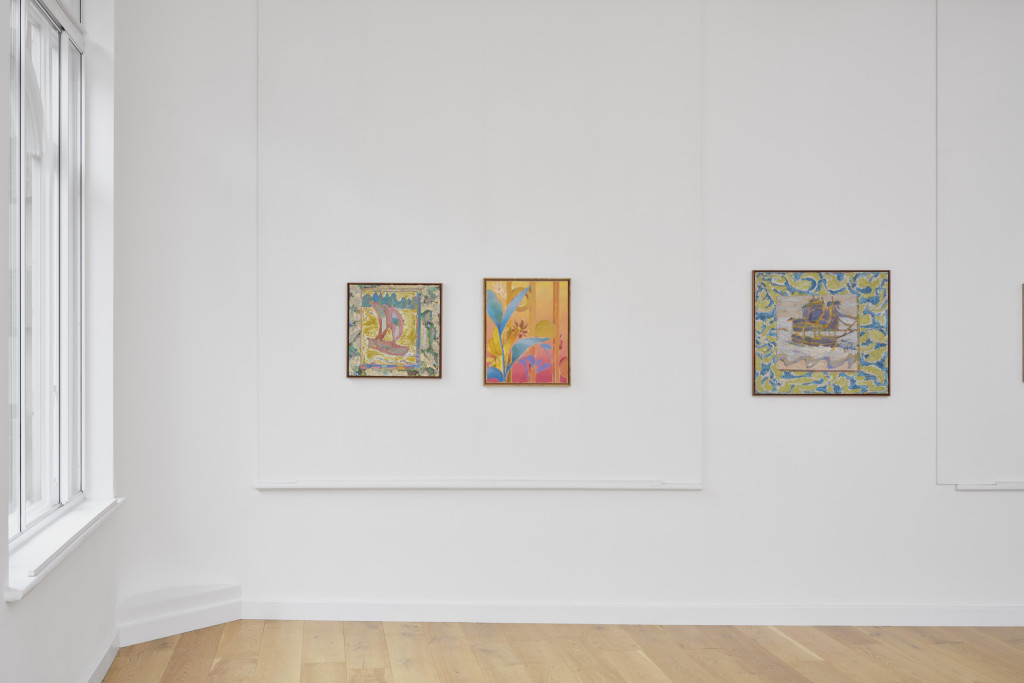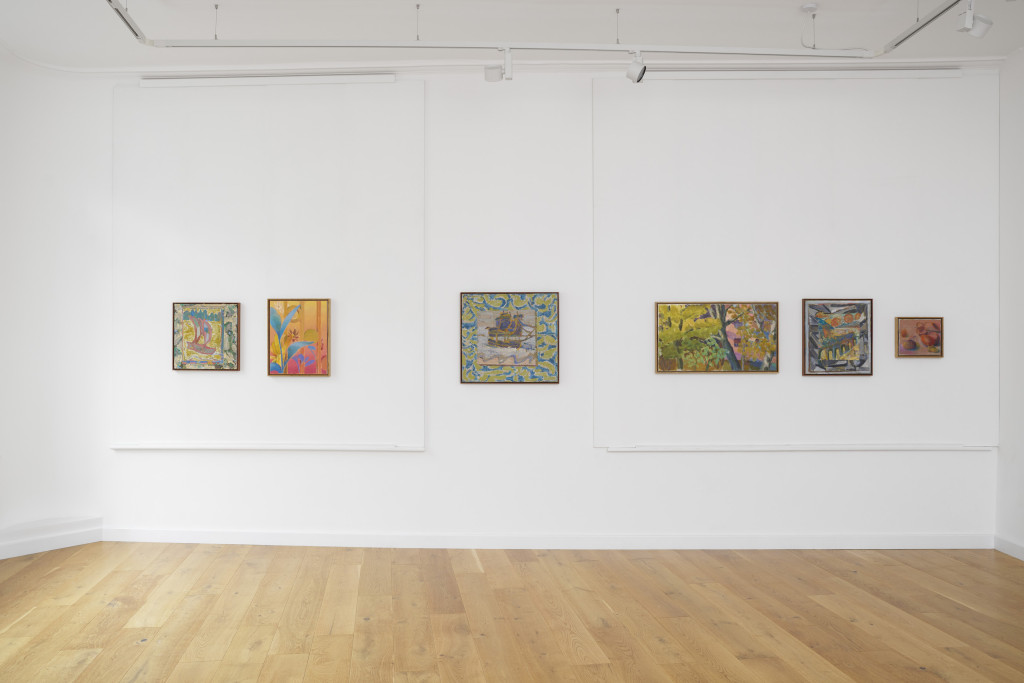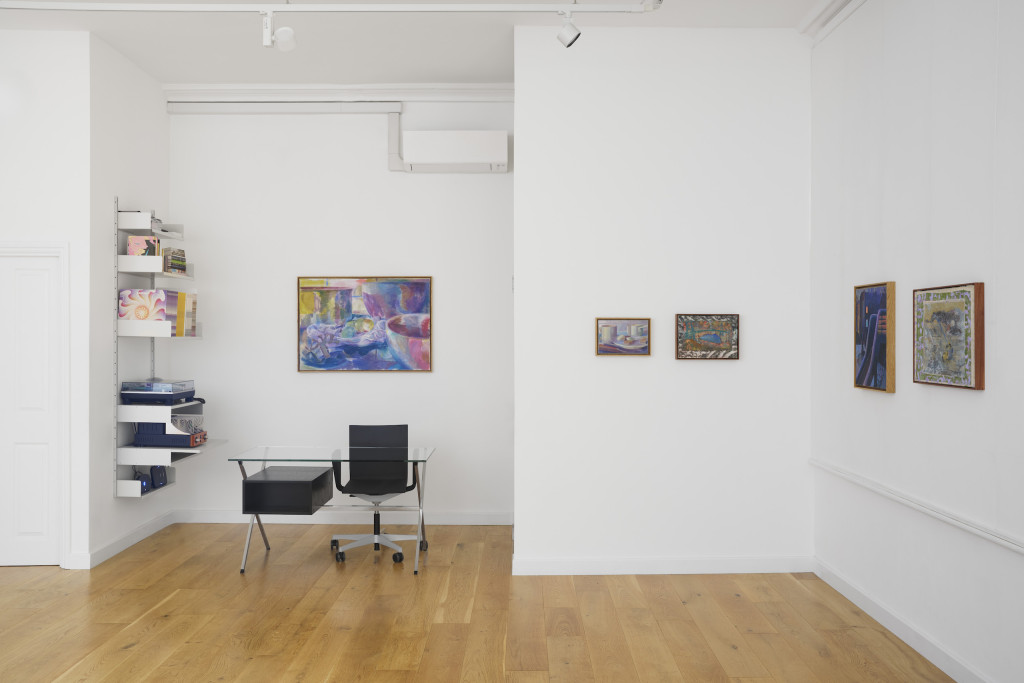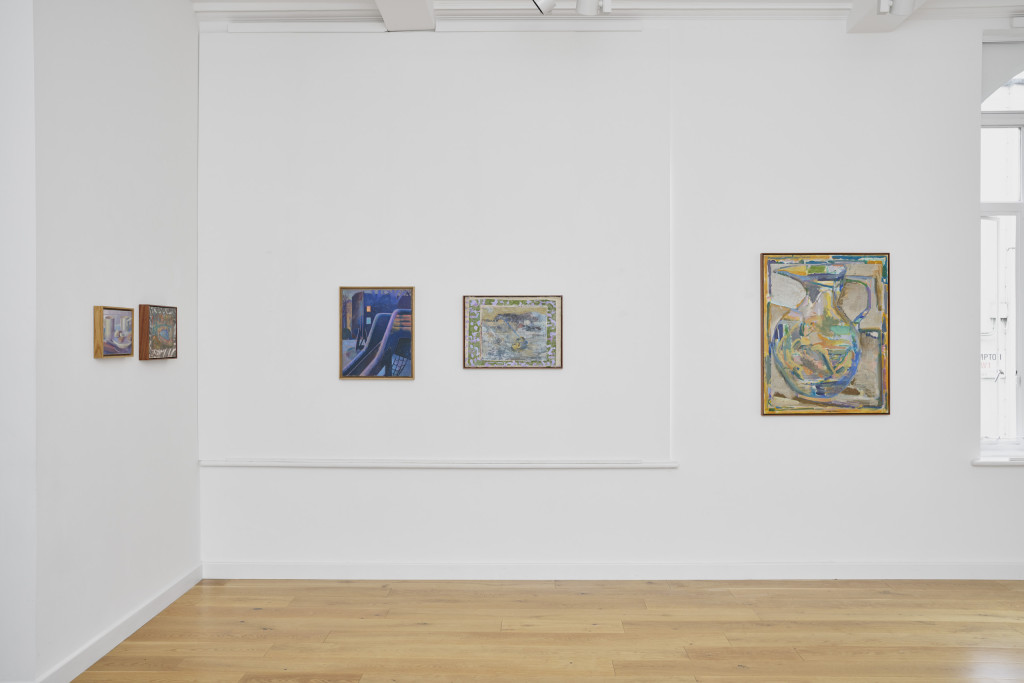If you would like to request an exhibition catalogue please email: cedric@cedricbardawil.com
Arcadian Minds features new works by Anthony Banks and Alex Gibbs. In dynamic, time-worn, and textured representations of space and place – from an altbau kitchen in Berlin to the post-industrial landscapes of the West Country – both artists engage with the history of the British landscape tradition in our own time. Having both been prodigal talents as painting students at the Royal College of Art, Banks and Gibbs developed a fruitfully rivalrous friendship as their own distinct sensibilities towards the materiality and meaning of mark-making in paint took their work in different directions. For the first time, their works are shown together and in conversation. While both artists are concerned with the revelatory in the everyday, and the compositional possibilities of a kind of “provincial” vernacular of painting, their work offers distinct directions for the future of site-responsive painting. The exhibition title, Arcadian Minds, refers to the imagined constitution of a kind of rural idyll: these are paintings of paradise and loss, the countryside and a perpetually furtive home, all the while grappling with the role of a cherished and contested medium – painting – in the contemporary moment.


What is dawn in the city to an elderly man standing in the street looking up rather dizzily at the sky? Dawn is some sort of whitening of the sky; some sort of renewal. Another day; another Friday; another twentieth of March, January, or September. Another general awakening. The stars draw back and are extinguished. The bars deepen themselves between the waves. The film of mist thickens on the fields. A redness gathers on the roses, even on the pale rose that hangs by the bedroom window. A bird chirps. Cottagers light their early candles. Yes, this is the eternal renewal, the incessant rise and fall and fall and rise again. – Virginia Woof, The Waves (1931)
In Virginia Woolf’s The Waves, one of artist Alex Gibbs’ favourite novels, we encounter the revelatory in the everyday. To the uninitiated eye, the picture that the modernist master presents is of a world like any other: dawn is breaking, a rose stands in a bedroom vase, country-dwellers rise from their slumber. And yet there is something else at play here: the repeated emphasis on the scene as distilling an unnamed ‘awakening’ and ‘renewal’ speaks to something beyond the mere diurnal rhythms of night into morning. Part of the reason why I believe this novel resonates with Gibbs, and helps shine a light on fellow artist Anthony Banks, a restless observer of the overlooked, is that these lines illuminate the ways that, even on a drab morning in the city, we are connected to something extraordinary. While both artists are concerned with the revelatory in the everyday, and something close to what Woolf describes as ‘the eternal renewal’, as well as the compositional possibilities of a kind of “provincial” vernacular of painting, their work offers distinct directions for the future of site-responsive painting. The exhibition title, Arcadian Minds, refers to the imagined constitution of a kind of rural idyll: these are paintings of paradise and loss, the countryside and a perpetually furtive home, all the while grappling with the role of a cherished and contested medium–painting– in the contemporary moment.
When one spends time with works by these two artists, we can quickly identify a singularly shared set of concerns: of a touch of English attention to detail, of a reverence for landscape even when that reverence delights in the acknowledgment that this place lacks refinement, of the way that ‘we’ (that ever amorphous, self- parodied ‘we’) like to talk about subtle changes in the weather. But these supposedly national concerns, which can be identified as somehow familiar even as the exact nature of them shifts, are actualised even further by the distinct genealogy, predominantly British, that these artists recognise their work: Paul Nash, Ivon Hitchens, Eric Ravilious, Winifred Nicholson, Duncan Grant, Graham Sutherland, and Stanley Spencer. Of all these artists, it was Nash who struggled most with the task of defining a national identity of modern art and was regretful that it seemed so hard to be a modernist while still working in a native tradition. In 1932, Nash made this struggle explicit, a struggle that continues to animate the work of both Gibbs and Banks: ‘Whether it is possible to ‘go modern’ and still ‘be British’ is a question vexing quite a few people today […] The battle lines have been drawn up: internationalism versus an indigenous culture; renovation versus conservatism; the industrial versus the pastoral; the functional versus the futile.’ Both Gibbs and Banks resist many of these binaries: their work is decidedly internationalist in scope and sensibility, while representing something of a historically-minded arc back into British painting, all the while looking at the boundary line between the industrial and the pastoral.
Many of Banks’ paintings, such as Bridge and Barge (2009-24), depict those spaces where human-built infrastructure or the machineries of capitalist manufacturing intersect, loom over, or otherwise are held in tension with the natural world. In both form and subject, Banks’ landscapes and still lives are positioned on the margins and reconcile those extremes that Nash identified nearly a century ago. Over the last decade, Banks has built a celebrated reputation as a real painter’s painter, and as an artist whose commitment to the craft of mark-making has become a defining part of his practice. Gibbs believes this is partly due to ‘the prolonging of the painting process, the idea that a painting can be worked on for more than a year.’ Indeed, Banks’ paintings regularly take years to complete. They are made and remade. What has become compelling, too, is the ways in which he returns to the same subjects as though they, too, are rekindling conversations with previous versions of paintings; past presences of past lives.
Banks and Gibbs met as talented postgraduate students the Royal College of Art. In difference to today’s London art schools and wider market, where painting and once derided ‘traditional’ forms of still life and landscape are once again in the ascendancy, the atmosphere of the Royal College, which once trained David Hockney and Frank Auerbach, was then hostile to oils and canvases. ‘I’d gone from Brighton, where the whole school was full of studios that stank of oil painting and turps, and ten years of devotional practice to painting’, Banks reflects, ‘to the Royal College, where painting was unfashionable and there was very little belief in what could still be done with the medium.’ For both Banks and Gibbs, a veil dropped: painting was not the heroic and worthy pursuit that these two artists from the provinces believed it to be. Gibbs remembered the inter-departmental crits, when apathetic curatorial students descended on the cold studios and ‘arrived with guns in their holsters… one student asked, indignantly: “why are you still painting?”’ Someone should stand up for the medium, they felt. The trouble with the maxim ‘painting is dead’, which has been thrown about at various intervals since French painter Paul Delaroche first changed upon his first daguerreotype at the advent of photography, is that there will always, for now at least, be someone to stand up for painting and to ensure its liveliness in a new age. ‘Painting has the right to exist because it’s there: it exists’, Gibbs says, with a sense of forcefulness that belies the seeming modesty of his paintings. For Gibbs, as for Banks, the handling and gesture of paint must work all the harder when its spare subject matter is not spectacular. Or, to put it differently, the wonder that accompanies those moments when the spectacular can be found in a spare subject.
It is this–finding the spectacular, or something like an ideal, in spare subject matter–which activates what might be called ‘an arcadian mind.’ Both artists live away from home: Banks, who was raised in Gloucestershire now works in Bow; Scottish Gibbs, whose family still live in Edinburgh, upped sticks to Moabit, on the eastern edge of Mitte in Berlin. ‘You go home and it’s not your home’, Banks reflects: both artists feel nomadic, have a reverence for their childhood, but recognise that, for each, home is found in their artistic pursuits. But why might we call Banks and Gibbs arcadian? Named after a mountainous district in the Peloponnese of southern Greece, in poetic fantasy it represents a pastoral paradise, a provincial utopia, where noble savages roam about uncorrupted by civilisation. In art history, we might find this place in Thomas Cole’s The Arcadian or Pastoral State (1834), in which shepherds tend their flock under a bucolic canopy of trees, or, earlier still, in Et in Arcadia Ego (1637-1638) which features idealised peasants read the painting’s title on an austere tomb–and translates from Latin as ‘Also in Arcadia am I.’ While Gibbs and Banks refuse their paintings to be sentimental for the pastoral– they do not suggest we take up our lot with the shepherds–they, like Cole’s peasants, find solace in the idea and the imagination of a world far from city life. For them, Arcadia is less a place to be sought out but something to conjure, in the white heat of a capital city, wearily walking on concrete and clay, in art.

As such, the artists describe themselves as ‘two arcadian minds away from arcadia, lost somewhere in urbania’, a neologism partly invented by Gibbs, and partly a reference to those places in cities where the throng of a metropolitan centre and suburbia coalesce, as a kind of oxymoron. But it is also clear what Gibbs is referring to here: his still lives of tidied up plates and cups, of playgrounds at night (and so not when it is being used, useful, and active), often bear the residues of places where excitement and mundanity mix, happily and unhappily. ‘One of the things that bring these objects together is the closed geographical space: the fence, the kitchen sink’, Gibbs reflects: ‘you’re not painting the cake, you’re painting the crumbs on the plate after it’s been eaten.’ When I look at Ablution (2024), a picture of cups, pans, and cutlery on the kitchen- side which is now bathed in luminescent pinks and blues, and where the rectangular tiles on the far wall seem to apply a quasi-cubist logic to the overall composition, I think of the way that table- top of dinner party joviality is this table-top of domestic labour. I think of Nash’s tension between the functional and the futile.
Somewhat like Giorgio Morandi, who very rarely left his hometown of Bologna and painted the same cylindrical vases, bottles, bowls, and flowers over a long life, Gibbs leads something of a monastic life. Beyond painting, which he painstakingly commits to every day in a small, converted studio within his apartment, his days are punctuated by taking care of Ivor, his son, including dropping him off at kindergarten and playing with him in playparks, a regular subject for his paintings. At weekends, Gibbs is an inveterate visitor to Berlin’s plethora of flea markets. The market at Rathaus Schöneberg is particularly conducive to the revelation of forgotten or throwaway treasures, as the artist snaps up records, leather shoes, and amateur children’s paintings. Most recently, however, Gibbs has taken up collecting dog-eared painting monographs, many of which were published in former East Germany. The traces of some of these books, such as those on artists like Werner Heldt and Ernst Ludwig Kirchner, can be found in this new body of work. Kirchner was one of the leading artists of Die Brücke, the Dresden-based Expressionist outfit who, like Gibbs, looked at the city with piercingly perceptive eyes, finding those moments when the mundane is transformed into something meaningful, and reimagining those scenes in vital polychromatic washes of paint. Like Heldt and Kirchner, Gibbs recognises that, as an artist, one must paint what one knows; including, to be sure, where one knows.
For Banks, Gibbs represents the most original kind of contemporary painter, one who seems at odds with the pace, distraction, and immateriality of our screen-obsessed age–in short, at odds with the contemporary life of the modern city. In large part, this is because of Gibbs’ celebration of the solitary act of painting, and what he describes
as the ‘paintings of the everyday.’ We should see Gibbs’ approach to making, early morning after evening, if not always his subject matter or compositional singularity, as part of that line of artists whose attention to the quieter corners of the world comes first and is held in sacrosanct distance from the hubbub of the centre. In this way, his work shares with Richard Diebenkorn’s landscapes a studied gaze at modern life, as outsiders who observe the human carnival from a distance, but with a telescope. Like Diebenkorn, who painted freeways without cars, and diners without patrons, Gibbs represents cities without people: those places that continue to exist when everyone has stopped looking. While Banks admired Gibbs because of his ‘outgoing, fun- loving character, who was a big presence in the studio’ at the Royal College, he respected the way Gibbs cultivated ‘a reality of his work which was quieter and more intimate, introspective and full of sincerity, that demanded a lot of the viewer without ever shouting at them.’ With that said, there is an obstinacy to Gibbs’ paintings. They seem to also say, in a quiet but determined voice, that ‘this is what I have to show you.’ There is no hanging apology or unspoken modesty here, merely the deliberate reworking of his subject matter which firmly insists on its own reason for being.
For both artists, the call of painting means something. It is not lip service to fad or fashion. Their commitments will not wane, should painting once more be called dead or dying. From the first, Banks and Gibbs have set out their stall as romantic moderns, and as arcadian chroniclers of the city, whose incandescent paintings emerge in the eternal renewal.
Exhibition catalogue essay by Matthew Holman



